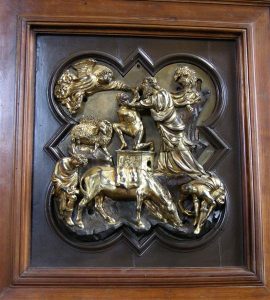Lorenzo Ghiberti, Filippo Brunelleschi, and the Competition Panels
Among the most ambitious sculptural projects of the Early Renaissance was the continuation of the series of doors for the Florentine Baptistery, one pair of which, showing the life of John the Baptist, had been made by Andrea Pisano in the 1330s. Two more sets, intended to illustrate the Old and New Testaments, were needed to decorate the other two portals of the building. In 1401, the Opera (Work) of the Baptistery announced a competition for the second set of doors. The subject selected for competition was the Old Testament story of how God tested the faith of Abraham by commanding him to sacrifice Isaac, his only son. Abraham, accompanied by two servants and a donkey, took Isaac into the wilderness, but just as he held the knife to his son’s throat, God sent an angel to tell him that the Lord was pleased by his faith and would be satisfied with the offering of a ram caught in a nearby thicket. The story was interpreted as foreshadowing the sacrifice of Christ, but the Opera may have had a more immediate reason for selecting it. The climax of the story emphasizes divine intervention, and the Florentines were facing a series of threats from outside forces.
The two preserved competition panels by Brunelleschi and Ghiberti represent the same moment in the story. Brunelleschi’s relief is an original creation, full of action-filled poses. Abraham twists Isaac’s head to expose his neck, while the angel has to rush in and physically restrain Abraham to prevent the sacrifice. This interpretation is profoundly human. The body of the boy is scrawny, the poses of the two main figures tense, and the drapery rhythms sharp and broken. All are rendered in a new, profoundly naturalistic style.

The young Ghiberti, who was trained as a painter but had not yet matriculated in any guild, displays extraordinary accomplishment in handling bronze. In his interpretation, the boy looks upward for deliverance from death. Abraham, his arm embracing the boy, is poised with the knife pointed toward but not touching his son. The foreshortened angel stops the sacrifice with a gesture. The ram rests quietly before his thicket, while the servants converse gently. There is none of the physical contact and psychological strain of Brunelleschi’s relief, and his jagged movements are replaced in Ghiberti’s work by poses as graceful as those of dancers. Throughout Ghiberti’s composition – in every figure and drapery fold and even in the rocks – curving rhythms create an effect of continuous melody.

Ghiberti’s flowing lines draw our attention to the body of Isaac, which is the first truly ideal Renaissance nude; here naturalism and classicism are blended and sublimated by a new vision of what a human being can be. Not since the last Roman sculptor capable of imitating a Greek or Hellenistic original had such a nude been created. Ghiberti’s Isaac was certainly inspired by a study of ancient Roman nude figures, and other references to classical antiquity are evident in the reliefs. In both, the head of Abraham shows the inspiration of ancient Roman heads of Jupiter. The servant plucking a thorn from his foot in Brunelleschi’s panel is based on a popular Roman sculpture, the Spinario, of which many ancient versions survive.

There are significant technical differences between the reliefs. Brunelleschi’s is composed of a bronze sheet to which the individually cast figures are attached, while Ghiberti’s background and figures are cast in a single continuous piece, with the exception of the figure of Isaac, which was attached. Ghiberti’s relief is, therefore, stronger and, because his figures are hollow, his relief is only about two-thirds as heavy as Brunelleschi’s. The judges of the competition would surely have realized that doors made following Ghiberti’s technique would be both more durable and require less bronze. Such differences may have helped make Ghiberti the obvious winner in the competition.[1]

Don’t feel to badly for Brunelleschi. He will go on to develop one-point linear perspective and design the dome for the Florence Cathedral.
- Frederick Hartt and David G. Wilkins, History of Italian Renaissance Art, 7th edition, (Upper Saddle River, NJ: Prentice Hall, 2011), 181-183. ↵

